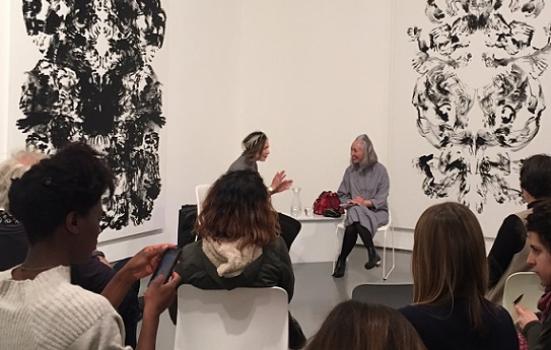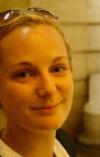Ruth Bretherick explains how she overcame the challenges of programming events when an exhibition split across two arts venues: one in Edinburgh, and one in Dundee.

The challenge
In my first week as Research and Interpretation Curator at The Fruitmarket Gallery in Edinburgh, myself and two colleagues (Iain Morrison, Enterprise Manager and Tracy Morgan, then Learning Programme Manager) took a trip to Dundee to talk to the team at Dundee Contemporary Arts (DCA) about programming events for an upcoming exhibition. MARK WALLINGER MARK (4 March to 4 June 2017) was to be an unusual exhibition, in that it was split across two venues, with half of the works shown in Edinburgh and half in Dundee.
As the meeting continued, the challenge of cross-venue programming became apparent: our organisations have different staff structures, meaning that each of us would not have a direct counterpart to liaise with; we allocate our budgets differently, so that each institution would have more to put into one type of event than another; and being a gallery and a multi-arts organisation respectively, our audiences are different, meaning that some types of event would be more successful in one venue than another.
How I solved it
My starting place was the exhibition: its content, its format and a consideration of the broader practice of Mark Wallinger. The central themes of the exhibition were identity and mirroring. Across both venues the linchpin was a selection of ‘Id Paintings’, large black and white symmetrical paintings resembling Rorschach inkblots, made by rubbing paint directly onto the canvas with both hands. The title of the exhibition was also a form of doubling and assertion of the self – MARK WALLINGER MARK – the artist making his ‘mark’ twice, across two venues. I devised an event format that embraced this, and Wallinger’s love of wordplay: TALK TRACK TALK was intended to reflect the exhibition title and form, with a talk at one venue, a train journey, and a talk at the other venue.
My starting place was the exhibition: its content, its format and a consideration of the broader practice of Mark Wallinger
The event aimed to take advantage of the proximity of both venues to the train stations of each city. Since public transport and train journeys have been an important part of Wallinger’s wider work (see for example, Labyrinth, commissioned by Art on the Underground), I wanted the train journey itself to be an integral part of the event. This meant discussion between participants on the train, fueled by questions, reading and images (dubbed the ‘track pack’).
Right away, I asked the directors of the respective institutions – Fiona Bradley at the Fruitmarket, and Beth Bate at DCA – if they would be willing and available to take part in such an event and give talks. Both directors embraced the venture, keen not only to speak at their respective galleries, but also to be involved in the whole day. Suggestions for further speakers came from the directors, and from their particular areas of interest. Beth wanted to explore the psychoanalytic side of the work – to unpack the ego, superego and id of Freud’s writing. In contrast, Fiona was interested in looking at public identity through Wallinger’s work, asking how we present ourselves to the world. To complement the directors’ talks, the other invited speakers were David Hopkins from the University of Glasgow at the Fruitmarket, and Anouchka Grose, Psychoanalyst at the Centre for Freudian Analysis and Research in London, at DCA.
Once I had the speakers in place, the practicalities of the day reared their head. With packed lunches (provided by the Fruitmarket’s café) and discussion materials to organise for the train journey, I also had to make sure the trains lined up – so that participants coming from Dundee could join us for the first talk at the Fruitmarket, and we could all be in the same carriage on the journey up to Dundee for the discussion.
Since I had conceived this event, I took on the majority of its organisation, but liaised with staff at DCA about the practicalities. The different staff structures meant I was not just in touch with one counterpart at DCA, but staff from across learning and marketing. These discussions helped me to take into account variations in expected audience numbers from each city, and different budget allocations from each venue.
One of the overall challenges of MARK WALLINGER MARK was making audiences aware that there were two halves to the exhibition, and encouraging them to go to both venues. For its participants, TALK TRACK TALK succeeded in doing just that. They reported that they enjoyed both the structured and collaborative nature of the event and the means to see both exhibitions in one day. They found the discussion aboard the train engaging and the speakers intelligent, “offering generous ways into very complex ideas”.
My colleagues at both venues programmed other events, taking up the challenge in different ways and for different audiences. Mark Wallinger was delighted by the events that surrounded his exhibition, and came up to Scotland from London to be involved in one or two of them.
Although cross-venue programming can be challenging, the experience is both a fantastic way to learn from one’s peers across institutions, and enriching for audiences who take part.
Ruth Bretherick is Research and Interpretation Curator at The Fruitmarket Gallery, Edinburgh.
www.fruitmarket.co.uk
E ruth@fruitmarket.co.uk
Tw @RuthBretherick




